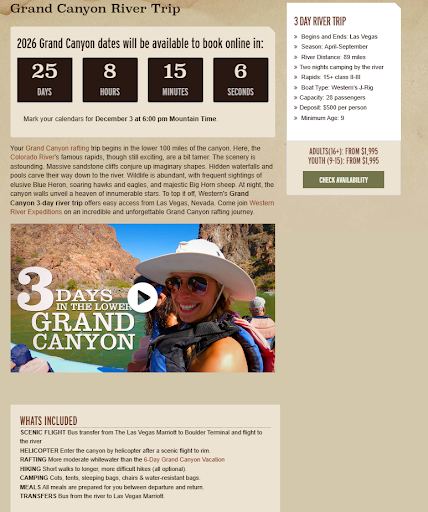How to Create Multi-Day Tour Sales Pages That Actually Convert
A $2,000 rafting trip down Cataract Canyon requires a completely different sales approach than a two-hour food tour. Yet most multi-day tour operators treat their sales pages exactly the same as their shorter experiences.
The result? Potential guests leave without booking—and often without even sharing their contact information.
Think about it: When someone is considering a multi-day adventure, they need to coordinate time off work, arrange travel plans, and justify a significant investment. They’re not making a spontaneous decision. They’re researching, comparing options, and likely visiting your website multiple times before committing to book.
Your sales page needs to address this careful decision-making process.
Here’s what’s interesting: The highest-performing tour companies aren’t necessarily the ones with the most spectacular photos or the fanciest websites. They’re the ones who understand exactly how to structure their sales pages to guide potential guests through their decision-making journey.
After analyzing thousands of tour websites and helping operators optimize their pages, we’ve identified the specific elements that consistently drive bookings.
Let’s break down exactly what works—and what doesn’t—when selling multi-day tours online.
Key Elements Every Multi-Day Tour Page Needs
Names and Bold Promises
Your tour name needs an irresistible promise underneath it. For example, a rafting company effectively promises: “Raft, hike, and soar through Cataract Canyon’s wonders, ride class four rapids, explore ancient ruins, camp under starlit skies, and fly over breathtaking Canyonlands, all in one unforgettable four-day adventure.”
Strategic Call-to-Actions
Multi-day tours need two distinct CTAs:
- Primary: “Check Availability” – leading to your booking calendar
- Secondary: “Request Detailed Itinerary” – capturing email leads
When someone requests an itinerary, offer clear benefits: “Get instant access to detailed river maps, day-by-day adventure breakdowns, seasonal insights, and packing tips from veteran guides.”
This approach helps qualify leads—someone downloading a detailed itinerary is typically more serious about booking.

Media Placement
Place your photo gallery near the page top. For stunning video content, position it above the fold. The Western River Expeditions page exemplifies this, showcasing their video prominently before transitioning to a full gallery of trip highlights.
Essential Trip Details
Place critical information where it’s instantly visible:
- Price
- Duration
- Location
- Time of year
- Group size
- Activity level
- What’s included/not included
Natural Urgency Elements
Multi-day tours have built-in scarcity – use it. For example: “Cataract Canyon is one of Utah’s premier rafting destinations and our four-day expeditions often fill up months in advance. To secure your preferred date and avoid disappointment, we strongly recommend booking as soon as possible. Peak season trips June to August typically sell out first.”
Magic Moments and Sensory Details
Instead of dry itineraries, paint vivid pictures: “Breathe in the crisp morning air scented with sage and juniper as the sunrise paints the canyon walls in a golden glow. Drift along the Colorado River, letting your fingers trail in its cool waters as you marvel at ancient rock formations.”
Building Trust Through Social Proof
Display credibility markers prominently. For example, “4.9 stars out of 2,025 reviews” and “15,000 adventurers since 1961” above the fold or this example from Kailani Tours. Include partner logos, awards, and media mentions to reinforce trustworthiness.

Risk Reversal
Place guarantees prominently. The “Lowest Price Guarantee” should appear near your booking button. Highlight flexible payment terms and early booking guarantees. Remember, this isn’t about being the cheapest – it’s about assuring guests they’re getting the best value booking directly with you.

Smart FAQ Implementation
Use an accordion-style FAQ section on the same page as your tour description. Cover key concerns:
- Food and dietary information
- Reservations and cancellations
- Group booking details
- Travel with children policies
Here’s a great example from Bulldog Tours in Charleston.
Important Notes Section
Be direct about qualifications. For example, “If you struggle with walking on uneven surfaces for up to three miles a day, then it’s probably not the best tour for you.” This transparency leads to better-fit bookings.
Mobile Optimization
Include a sticky bar showing:
- Price per person
- Deposit amount
- Both call-to-action buttons
Add a navigation bar that replaces the menu as users scroll, helping them quickly jump to relevant sections.
Remember, selling multi-day tours isn’t about flashy designs – it’s about presenting the right information in the right order. These elements, when properly implemented, help potential guests move confidently toward booking your experiences.
Want to see how your page measures up? Start by checking if you have these core elements in place. Often, small adjustments to your existing page can lead to significant improvements in booking rates.


